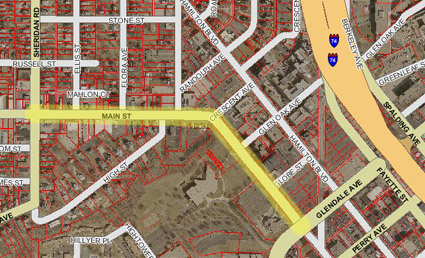According to the Journal Star’s “Word on the Street” column, Second District Council Member Barbara Van Auken “wants Main to be considered a priority again.” While I welcome efforts to move Main Street back onto the priority list, I have to wonder what is meant by “priority.” The same amount of money for Main Street improvements has been budgeted in 2010 as was budgeted in 2009: $0. Lack of funding was the reason given for moving Main off the priority list in the first place back in November 2008.
The article goes on to explain that, specifically, she’d like to see additional parking and property redevelopment along the stretch from University to Methodist. “[Additional parking is] an inexpensive thing we can do on the short term and hopefully slow the traffic down, making (exceptions) for the so-called rush hours in the morning and afternoons.” I presume she’s talking about on-street parking, given that only on-street parking would have a traffic calming effect. I agree that adding parking on Main is relatively inexpensive and easy to do (plus it would make Main more pedestrian-friendly and offer easier access to businesses). But why then was it not done last year? Why did she support the addition of off-street surface lots in the West Main form district instead?
“‘I’m trying to work with all of those property owners to the maximum extent possible to redevelop that entire block and look at some of the parking issues and some (improvements) of the facades and that sort of thing,’ Van Auken added.” Great, but facade improvement and property redevelopment are private investments, not public ones. In fact, several businesses have already improved their Main Street facades. When is the city going to do its part in improving the streetscape?
Public Works Director Dave Barber was also interviewed for the article. Notably, the paper said he “estimates it will cost $12 million” to make “a considerable impact on Main.” The figure includes the cost to “reduce the street’s lanes, landscape it and make it more pedestrian friendly.” In November 2008, the estimate for this same work was $10 million. So the estimated costs have risen 20% in 14 months. The longer we wait, the more expensive it becomes.
I appreciate the pro-revitalizing-Main-Street rhetoric, but frankly I’m tired of talk. All we’ve done is talk for seven years. Let’s see some action. Let’s see some money appropriated for it. Let’s see an RFP go out to perform the work. And don’t tell me we don’t have the money. Any city that can afford to give $39.3 million to a hotel developer (downtown Marriott), lease its prime real estate for $1 per year for 99 years (Sears block), tear up its railroad infrastructure (Kellar Branch), and turn its industrial park into a greenfield for low-wage big-box stores (Pioneer Park) obviously has money to burn.
When it comes to priorities in Peoria, actions speak much louder than words.

 On Tuesday night’s City Council agenda is a grant application to the Federal Highway Administration’s “Highway Safety Improvement Program” to improve Main Street from Sheridan Road to Glendale Avenue (see map to the right). This corridor would be eligible for funding because it is a “high accident location” and because it has a “high cost benefit ratio,” according to the
On Tuesday night’s City Council agenda is a grant application to the Federal Highway Administration’s “Highway Safety Improvement Program” to improve Main Street from Sheridan Road to Glendale Avenue (see map to the right). This corridor would be eligible for funding because it is a “high accident location” and because it has a “high cost benefit ratio,” according to the  The
The